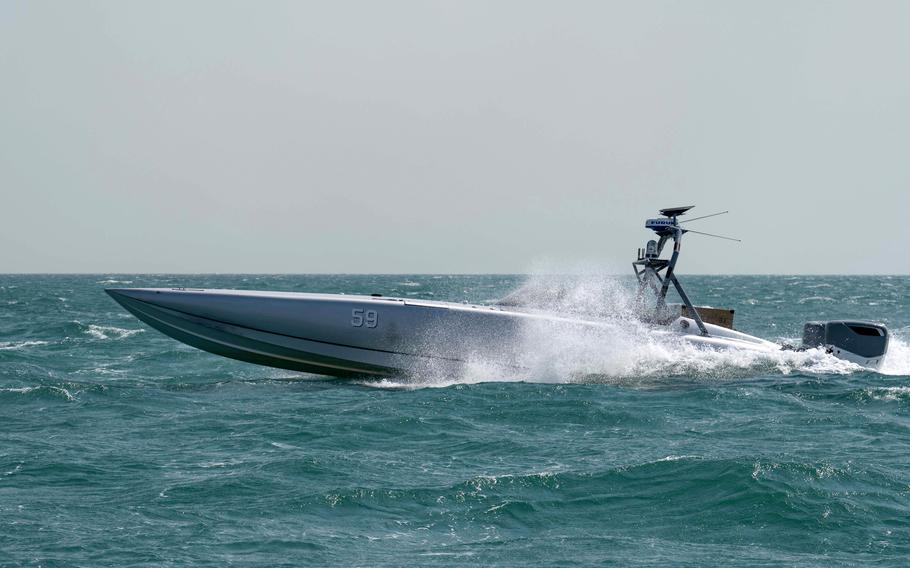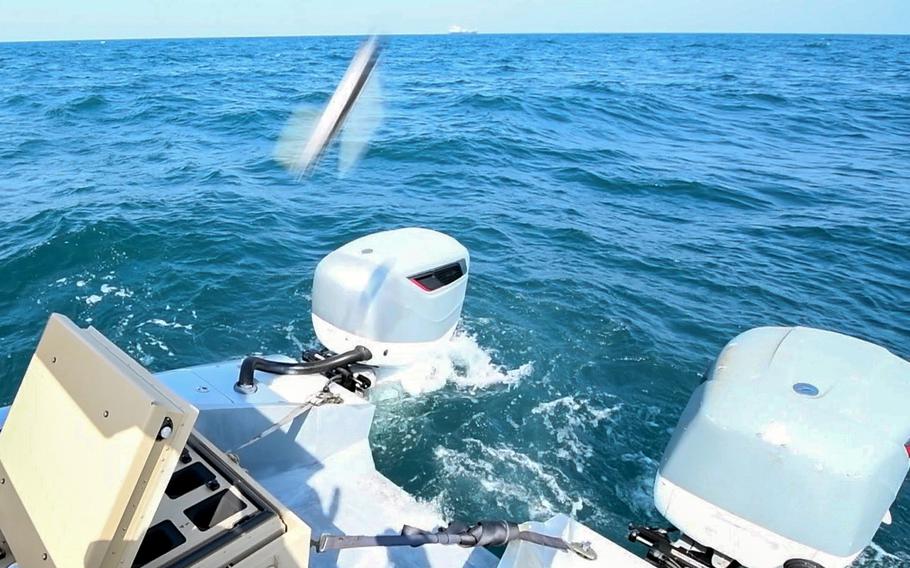
A MARTAC T-38 Devil Ray unmanned boat operates in the Persian Gulf on Oct. 26, 2023. In the recent exercise Digital Talon, missiles were launched from the surface drones. Each one scored a direct hit, a Navy statement said. (Jacob Vernier/U.S. Navy)
MANAMA, Bahrain — The Navy’s use of a drone boat to fire missiles during a recent exercise in the Persian Gulf is a marker of more to come, the commander of America’s naval test unit in the Middle East said Wednesday.
Task Force 59, a unit known for using unmanned surface vessels to patrol the waters of the Middle East, is beginning work on arming drones with kinetic weaponry such as missiles, Capt. Colin Corridan, the unit’s commander, said in an interview at his headquarters in Manama.
The unit used an unmanned speed boat to fire Switchblade missiles in an exercise Oct. 23, marking the first use of lethal munitions by American drone boats in the region.
“We’ve made that leap,” Corridan said in his first in-person interview since assuming command of the task force in March.
While the unit will continue to build up its fleet of surveillance drones, Task Force 59 has “pivoted to kinetic,” Corridan said.
Future exercises will expand the number of combat-capable unmanned systems, statements by the Navy’s 5th Fleet have said.
The task force, which has about 30 staff members, is looking into giving its fleet of drone boats “electronic warfare” capabilities, Corridan said, using a term that commonly refers to jammers.
The unit also plans to develop drone boats that can operate if an enemy jams communication or denies access to GPS signals, Corridan said.
Asked if his unit is experimenting with the type of exploding drone boats that Ukraine has used in its conflict with Russia, Corridan did not rule the idea out, and said the command is considering an array of options for testing.
The Navy has not yet deployed armed drone boats on missions, Corridan said.

A missile is launched from a MARTAC T-38 Devil Ray unmanned surface vehicle attached to U.S. Naval Forces Central Command’s Task Force 59 during exercise Digital Talon in the Persian Gulf on Oct. 23, 2023. (Justin Stumberg/U.S. Navy)
Tensions in the Middle East between the U.S. and Iran and its proxy groups have flared up since the Oct. 7 attacks by Hamas against Israel, with American warships shooting down drones at least twice since then.
Navy officials have said they aim to rely more on unmanned vessels to keep an eye on Middle East waterways, through which much of the world’s trade transits.
Task Force 59 unmanned surface vessels have sailed the waters all around the Middle East since the unit was founded in 2021.
Drone boats have been used as part of increased patrols by the Navy in the Strait of Hormuz over the summer, as tensions between the U.S. and Iran flared over accusations that Tehran was harassing civilian shipping.
During the interview, Corridan pointed to a TV playing a video, taken by a drone boat of an Iranian ship, as an example of the type of surveillance these vessels are engaged in.
On two occasions in 2022, Iran took possession of drone boats before releasing them. But they have not taken any others since then, Corridan said, adding that the drones to be armed with missiles will be fast speedboats that can quickly move out of danger.